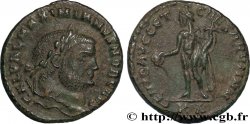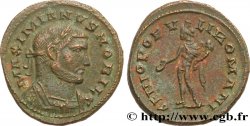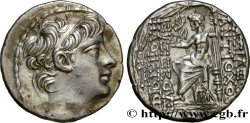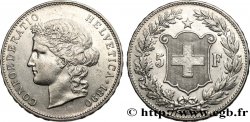v49_0765 - GALERIUS Follis ou nummus
MONNAIES 49 (2011)
Startpreis : 145.00 €
Schätzung : 300.00 €
Erzielter Preis : 145.00 €
Anzahl der Gebote : 1
Höchstgebot : 160.00 €
Startpreis : 145.00 €
Schätzung : 300.00 €
Erzielter Preis : 145.00 €
Anzahl der Gebote : 1
Höchstgebot : 160.00 €
Type : Follis ou nummus
Datum: 295
Name der Münzstätte / Stadt : Belgique, Boulogne
Metall : Kupfer
Durchmesser : 26,5 mm
Stempelstellung : 7 h.
Gewicht : 8,96 g.
Seltenheitsgrad : R3
Emission: 1re
Kommentare zum Erhaltungszustand:
Exemplaire sur un flan bien centré des deux côtés. Usure superficielle, mais argenture granuleuse et légèrement piquée. Très beau portrait. Joli revers
N° im Nachschlagewerk :
Pedigree :
Cet exemplaire provient de MONNAIES 43, n° 727
Vorderseite
Titulatur der Vorderseite G VAL MAXIMIANVS NOB C.
Beschreibung Vorderseite Tête laurée de Galère césar à droite (O*).
Übersetzung der Vorderseite “Galerius Valerius Maximianus Nobilissimus Cæsar”, (Galère Valère Maximien très noble césar).
Rückseite
Titulatur der Rückseite GENIO POP-VLI ROMANI/ -|-// -.
Beschreibung Rückseite Genius (le Génie) debout à gauche, le manteau sur l'épaule gauche, tenant une patère de la main droite et une corne d'abondance de la main gauche.
Übersetzung der Rückseite “Genio Populi Romani”, (Le Génie du Peuple romain).
Kommentare
Avec une partie de son argenture superficielle. Petite effigie. Rubans de type 2 aux extrémités bouletées. Portrait particulier. Exemplaire de la plus grande rareté. La titulature et le portrait sont très proches des folles lyonnais des trois premières émissions (294-295) et seraient donc frappés à Boulogne. Le follis n’est pas de Lyon et n’a pas eu la marque d’exergue arasée ou n’est pas mal frappée, la marque mal venue. Il s’agit d’un scalptor lyonnais comme l’a démontré le Docteur Pierre Bastien qui suit le “comitatus” de Constance Chlore qui s’apprête à passer en Bretagne afin d’affronter Allectus. Deux exemplaires répertoriés dans le corpus du Docteur Bastien en 1976 (B. 9a-b, pl. LXIX avec la césure POP-VLI et un avec la césure POPV-LI). C’est la quatrième exemplaire recensé. Prendra le numéro 9d dans le Supplément III du Bastien.
With part of its surface silvering. Small effigy. Type 2 ribbons with rounded ends. Particular portrait. An extremely rare example. The title and the portrait are very close to the folles lyonnais of the first three issues (294-295) and would therefore have been struck in Boulogne. The follis is not from Lyon and did not have the exergue mark leveled or is not badly struck, the mark badly placed. It is a scalptor lyonnais as demonstrated by Doctor Pierre Bastien who follows the “comitatus” of Constance Chlore who is preparing to go to Brittany to confront Allectus. Two examples listed in Doctor Bastien's corpus in 1976 (B. 9a-b, pl. LXIX with the caesura POP-VLI and one with the caesura POPV-LI). This is the fourth example recorded. Will take number 9d in Supplement III of Bastien
With part of its surface silvering. Small effigy. Type 2 ribbons with rounded ends. Particular portrait. An extremely rare example. The title and the portrait are very close to the folles lyonnais of the first three issues (294-295) and would therefore have been struck in Boulogne. The follis is not from Lyon and did not have the exergue mark leveled or is not badly struck, the mark badly placed. It is a scalptor lyonnais as demonstrated by Doctor Pierre Bastien who follows the “comitatus” of Constance Chlore who is preparing to go to Brittany to confront Allectus. Two examples listed in Doctor Bastien's corpus in 1976 (B. 9a-b, pl. LXIX with the caesura POP-VLI and one with the caesura POPV-LI). This is the fourth example recorded. Will take number 9d in Supplement III of Bastien








 Berichten über einen Fehler
Berichten über einen Fehler Die Seite drucken
Die Seite drucken Teilen meiner Auswahl
Teilen meiner Auswahl Stellen Sie eine Frage
Stellen Sie eine Frage Einlieferung/Verkauf
Einlieferung/Verkauf
 Details
Details















